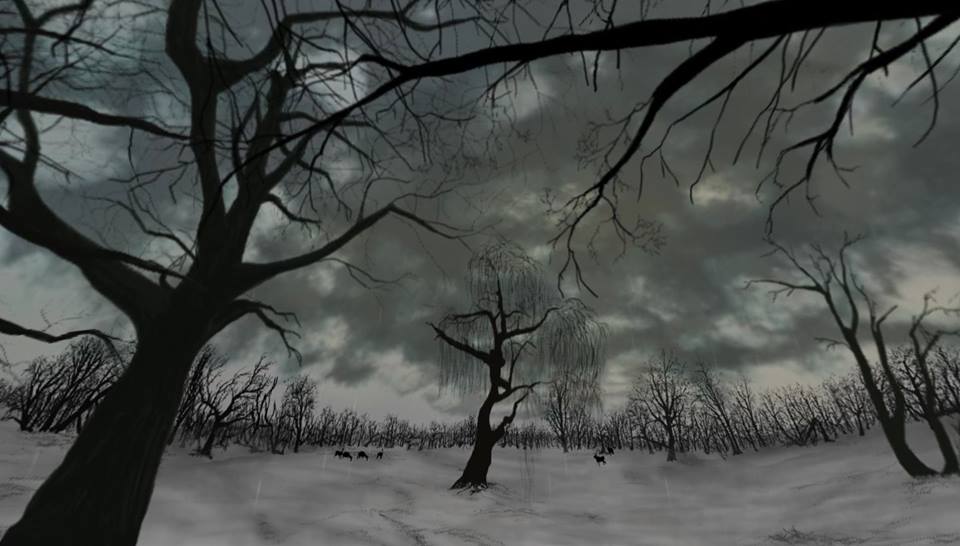Oeps, dat was wat je noemt een bliksembezoek. Na één avond in EYE was het Kaleidoscope World Tour VR Film Festival al weer op weg naar de volgende halte op de wereldtournee. Een demonstratieprogramma met een dertigtal voorbeelden van wat via virtual reality headsets van Samsung, Oculus Rift en anderen genoten kan worden. Bij die filmpjes zelf wil ik nu niet al te lang stilstaan – zie daarvoor andere voorbeelden in een eerder artikel. Al viel me weer op dat animatie het in de als werkelijkheidssimulatie bedoelde 360-gradenfilms vaak het beste doet.
Maar is het eigenlijk wel film? Ik heb met veel genoegen een tiental minuten doorgebracht in het winterse boslandschap van Februar, met uitzicht op een feestje in een verderop gelegen huis. Maarten Isaäk de Heer maakte deze animatie met steun van het Filmfonds, dat er aanvankelijk weinig in zag. Men miste namelijk een verhaal.

Daar raken we een gevoelig punt. VR wordt met van alles vergeleken – van film en games tot onderdompelingstheater en performance. Makers die in dit nieuwe en enthousiast gehypete medium een verhaal proberen te vertellen stuiten al snel op moeilijkheden. Wat volgens de ware VR-adepten alleen maar een teken is dat we met een geheel nieuw, nog onontgonnen medium te maken hebben.
Kaleidoscope-vertegenwoordiger Nick nam zelfs moeiteloos woorden als ‘incredible’, ‘awesome’ en ‘amazing’ in de mond, en suggereerde zelfs een ‘new level of consiousness’.
Dit ter inleiding van een panel met vier VR-makers die uitgenodigd waren hun licht over enkele brandende VR-kwesties te laten schijnen. Uit deze ietwat chaotisch verlopende Q&A met Arjan van Meerten, Daniël Ernst, Irene Vander Tig en Pierre Friquet viel in ieder geval het volgende te destilleren:
De technieken die de klassieke cinema van de afgelopen eeuw tot zo’n verbluffend effectieve verhalenmachine hebben gemaakt zijn in VR vaak nutteloos.
Montage is alleen maar verwarrrend – je moet er niet aan denken als toeschouwer om de paar seconden op een nieuwe plek te belanden. Een ander voorbeeld is de close up, die in VR niet bestaat. Ja, je kan in die virtuele werkelijkheid wel heel dicht bij iemand staan, maar dat is iets heel anders en vooral confronterend. Zoals wanneer ik na de woeste psychedelische kosmische trip van Waves onverwacht wordt gedropt op een strand, vlak naast een jonge vrouw in badpak.
Bij een andere gelegenheid had ik me ook al eens laten vertellen dat een klassiek filmgenre als slapstick in VR niet werkt omdat het te echt is. Dan valt er niet meer om te lachen.
Het heeft, zo legt het panel uit, alles te maken met de volstrekt andere positie van de kijker. ‘Wat moet ik doen’, vraagt die zich hier in eerste instantie af, in plaats van simpelweg toe te kijken als bij een film. Film werkt met codes waar we met het rationele deel van ons brein een verhaal van maken. VR werkt omgekeerd. Met ons onderbewuste beleven we het als echt, waarna de ratio ons vertelt dat het maar VR is.
Snap ik dit? Ik probeer het te vergelijken met een ritje in de achtbaan. Daarvan beweert ook niemand dat het een verhaal is. Daniël Ernst noemt zijn werkstukken diorama’s.
Tegen het eind stipt iemand nog de droom als metafoor aan, en dat lijkt me heel toepasselijk. Heel geslaagd waren voor mij tot nu toe VR-ervaringen waarin de zwaartekracht lijkt weg te vallen.
Terugkomend bij de vrouw op het strand: ze kijkt me aan en vraagt of ik zin heb in een wandeling. Ze loopt langzaam langs de waterlijn weg. Ik wil haar volgen, maar het lukt me niet van mijn plaats te komen.
Het Kaleidoscope-festival snelt weer verder. Voor wie op eigen gelegenheid in de VR-wereld wil duiken is inmiddels (of binnenkort) een keur aan VR-brillen beschikbaar. Van goedkope kartonnen kijkers (EYE heeft er een voor een tientje) waar je een moderne smartphone in schuift, tot de meer geavanceerde en duurdere modellen van onder andere Samsung, Sony, Oculus en HTC Vive. Met deze laatste kan je ook echt in de virtuele ruimte rondlopen en gebruik maken van game-achtige toepassingen.
Om de content te kunnen downloaden en beleven moet je doorgaans eerst een app installeren, zoals die bijvoorbeeld gratis verkrijgbaar is bij medeorganisator van het festival WeVR. Voor de VR-producties zelf moet betaald worden. Een dergelijke constructie zal in de toekomst vermoedelijk het belangrijkste distributiemodel worden.
Gratis VR is op deze manier al te bekijken via bijvoorbeeld de website van de New York Times.
Kaleidoscope, de hoofdorganisator van het festival, is een in San Francisco gevestigd bedrijf dat onafhankelijke VR-kunstenaars wil samenbrengen met producenten, fincanciers en distributeurs.
